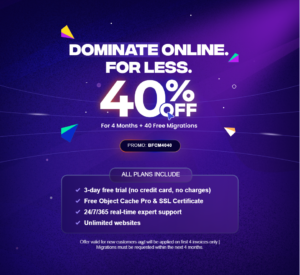Selling Divi child themes can be a profitable business. Not only are lots of developers looking for child themes to help them save time, but there are also many people building their website and they want a quality child theme to help them get started.
This article will provide a list of 12 tips for making money with Divi child themes. Stepping through the actual process of creating and selling a Divi child theme would require a multi-week course. Those details are beyond the scope of a simple article, but if you’re looking for a course then we cover that too!
1. Divi Child Theme Design
A child theme can be specialized to specific genres or it can be a multipurpose theme that can be used with any type of website. I recommend choosing a niche and focusing on what that niche needs. Even most multipurpose themes tend to focus on service-based businesses and provide pages that those businesses need. Choose colors, fonts, and images that are well-suited to the genre of your child theme.
Add real value to the child theme for the specific genres. For example, a multi-purpose child theme doesn’t suddenly become a dentist’s child theme just because it uses photos of dentist offices. Instead of relying on the photos, spend some time researching dentist websites and see what features they need and are unique to them.
2. Where to Get Ideas
My favorite places to get design ideas are web template shops and design sites. Theme and template stores, such as Envato Market or Creative Market, provide lots of themes and many of them include demos. The WordPress depository has thousands of themes. Even WordPress competitors have lots of templates for ideas.
Pinterest is a great place to get website design ideas. I recommend creating a Pinterest board just for inspiration. Search for amazing website designs and add them to your design board.
Don’t limit your searches to Divi child themes. Don’t even limit it to WordPress themes. Just search for website designs in general. It doesn’t matter what platform the designs are for.
Don’t copy someone else’s work. Instead, use it as inspiration. Take ideas from multiple designs and put them together. Put your spin on the designs and make them your own.
3. Package the Child Theme for Sale
All of your child theme files will need to be packaged in a zipped file. For a detailed discussion on this process, see the article How To Package a Divi Child Theme for Sale.
4. What to Include in the Packaged File
Design your child theme as a complete website. When you’re ready, export all of the elements that will be included in the child theme. Every child theme design is different, but here are the elements that most child themes need. Many will be files you can export.
Pages – Include a design for every possible page the website could need. This might only include a landing page, or it might include account, login, etc.
Theme Builder Templates – Use the Divi Theme Builder to create your headers, footers, and body templates for blog posts, category pages, archive pages, product pages, course pages, the 404 page, etc.
Menus – If your design includes some sort of navigation, be sure to include it.
Sample Post – Create a sample of the child theme’s custom post types to give users an idea of how to use them. This includes blogs, products, courses, recipes, appointments, etc.
Customizer Settings – Include customizer settings if you’ve made adjustments.
Widgets – Include widgets and link to any plugins that create them.
Divi Theme Options – Export the Divi theme options if you’ve made changes.
Divi Library – This is optional, but some developers prefer to include the page layouts in the Divi Library.
Bloom and Monarch – Include styling for both plugins if they’re a good fit for the child theme.
Icons – If you’ve included new icons, add them to the zip folder so users will have access to them.
Images – Include any images that have a license that allows for it. You can also use placeholder images that would inform the user of the ideal image size for each location.
Plugins – have your child theme to inform the user that certain plugins are needed. Many include styling for specific third-party plugins such as forms, courses, WooCommerce, etc. Don’t include premium versions of plugins in your child theme files unless you’ve worked out an agreement with the plugin publisher.
PSD files – designers use a range of tools for creating Divi websites. Some use Photoshop to create mockups. If you use Photoshop then you could include the PSD files to add value.
Documentation – create detailed documentation and include it in the zipped file as a PDF. It should step the user through installation and any customizations or unique features the child theme includes. It should also point to documentation for included plugins. Include links if documentation is handled through video or the publisher’s website.
5. Naming the Divi Child Theme
Use a name that sounds catchy and makes sense for the genre of the child theme, but make sure there isn’t another WordPress theme with that name. If there’s another theme with the same name, your theme will inform the WordPress admin when that theme has an update and the files for your child theme will be overwritten on the user’s website if they run the update.
6. Testing the Child Theme
Thoroughly test the child theme. Upload it to a demo site and follow your instructions step by step to make sure everything works as expected and to ensure that you’ve included all of the information. Test the demo site on as many devices, screen sizes, and browsers as possible.
7. Divi Child Theme Sales Page
You’ll need to provide the information for the sales page. Here are a few things your sales page will need.
Writing a Product Description – Create a product description that discusses the genre and the most valuable features of the child theme. Look at descriptions of your favorite child themes as examples. Pay attention to the real value of the child theme rather than things that come standard with Divi.
Child Theme Screenshots – Create a mockup of the child theme as seen within various devices. There are lots of mockup templates available. One excellent online tool is Am I Responsive. Simply enter your demo site’s URL and capture a screenshot.
8. Pricing Your Child Themes
Pricing can be tricky. There is no perfect answer and every child theme is different. If your child themes are too cheap they’ll be perceived as low quality. If they’re priced too high they’ll be ignored and those who do purchase will have high expectations.
The easiest method is to look at child themes with similar design quality and features that have great sales numbers to use as a model. Ask yourself how much you’d be comfortable paying for your child theme.
9. Hosting the Child Theme Demo
Create a demo of the child theme for buyers to see. This can be a multi-site or a stand-alone site. The demo should look like a complete website with high-quality images. Try to get multiple images of the same set.
There are several places to get good quality free and premium images. Free images usually don’t have a lot of sets to choose from and a lot of websites use them. Here are a few favorites:
- Shutterstock – This is one of the most popular websites for premium images. They’re royalty-free and there are thousands to choose from. It’s especially good for sets and images that haven’t been used as often.
- Unsplash – This site has thousands of royalty-free images that you can use without having to provide attribution.
- Pixabay – This one has almost 2 million free and royalty-free images to choose from.
If your child theme is available in shops, then don’t include purchase buttons within the demo. This will lead buyers through your CTA and shops that have spent time and money promoting your child theme will lose the sale. They’re promoting your child themes, so think win/win.
10. Support and Updates
Determine the type of support you will offer and make that information easy to find in your sales pages and documentation. Provide the support email in the documentation and on your support page on your website. You can also outsource support. Stay on top of support.
Don’t make the updates automatic. This can cause users to lose any customizations that they’ve added. Create a changelog to show what the update includes. Also, change the version number to show that it has updated.
11. Divi Child Theme Courses
There are lots of courses online that dig deep into Divi. Some include information about creating child themes for sale. Here are some of my favorite Divi child theme courses:
- Divi Academy – This course focuses on how to create Divi child themes for sale in the marketplaces. It goes deep into research, design, development, adding plugins, testing on multiple platforms, packaging the child theme for sale, hosting the files on your server, managing updates, and lots more.
- Site School – This course covers how to create a website from start to finish. It includes a lot of information about design concepts and also applies them to creating and selling Divi child themes online.
To find more courses for Divi, see the article 7 Best Resources to Learn Divi.
12. Where to Sell Divi Child Themes
We recommend selling your child themes right here at the Divi Cake shop. For information about becoming a child theme vendor see the Divi Cake sell page: Sell Your Divi Products.
Ending Thoughts
That’s our quick look at how to make money with Divi child themes. Creating high-quality child themes takes practice and skill, but it can be worth it in the long run. How much you can make will vary based on your design skills, the needs that it fills, your level of marketing, etc., but selling Divi child themes can be a great supplement to your income or even a full-time business.
Have you made money selling Divi child themes? Let us know about your experience in the comments.







0 Comments